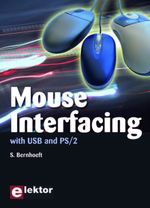Comment connecter une souris (USB ou PS/2) à un système embarqué
Infos. pratiques
ISBN : 978-0-905705-74-3
Auteur : Stephen Bernhoeft
Volume : 256 pages
Format : 170 x 235 mm
Epaisseur : 13 mm
Poids : 0,427 kg
Date de parution : 2009
Prix : 35,00 €
Langue : anglais

Contenu
Table des matières
- version PDF : Mouse Interfacing_Contents.pdf
- version HTML : voir ci-dessous
Couverture
- JPG : Mouse interfacing_cover_72ppp.jpg
- PDF : Mouse interfacing_coverHR.pdf
Site de l'auteur : ---
Présentation en français
Le sujet plutôt inattendu de ce livre suscite à première vue bien des interrogations. Pourtant la souris de nos ordinateurs est une des meilleures interfaces homme-machine jamais conçues. On n'y prête plus guère d'attention, tellement elle est universelle, précise et bon marché. Sa présence dans le monde des systèmes embarqués reste malheureusement rare, car peu de concepteurs jouissent d'une expérience pratique de la gestion d'une souris comme organe de pointage et de saisie.
Cet ouvrage explique soigneusement la réalisation du matériel et du logiciel nécessaires pour "actionner" l'entrée d'une souris sur de nouvelles applications à microcontrôleurs embarqués. Chaque étape est détaillée et immédiatement approfondie par un développement pratique, qui donne au lecteur l'élan pour aborder la suivante.
Les deux principales interfaces, PS/2 et USB, sont traitées et les conseils pratiques abondent, avec des exemples de matériel et de logiciel, ainsi que des astuces pour relier la souris à des microcontrôleurs typiques.
Parmi les sujets parfois très pointus abordés, on relève notamment ceux-ci :
- Profils balistiques pour une réponse à la fois rapide et précise
- Référence de tension, à 4 canaux, en millivolts
- Descripteurs USB
- Nombreux exemples avec code source intégralement documenté
Avec ce livre richement illustré, apprenez à connecter une souris (PS/2 ou USB) aux systèmes embarqués que vous concevez.
Présentation en anglais
The mouse is one of the best proven, widely used and inexpensive man-machine interfaces ever devised, yet its presence in the world of embedded systems is still a rarity. Indeed, there are few embedded engineers today having practical experience of how to implement the hardware and software required to 'enable' mouse input.
In Mouse Interfacing with USB and PS/2, the concepts needed are thoroughly explained. The practical development which stems from this knowledge is soon explored, with the feedback from each step providing impetus for the next.
This book describes in-depth how to connect the mouse into new embedded applications. It details the two main interface methods, PS/2 and USB, and offers applications guidance with hardware and software examples plus tips on interfacing the mouse to typical microcontrollers.
A wide range of topics is explored, including
- Ballistic profiles for fast-yet-precise response
- A four-channel, millivolt-precision voltage reference
- USB descriptors
- A variety of examples all with fully documented source-code
L'auteur
L'auteur, ingénieur en électronique à la retraite, vit au Royaume-Uni.
S. Bernhoeft lives in UK and retired as an Electronics Engineer.
Table des matières - Contents
Part 1 PS/2
1.1 The Mouse Hardware Interface
Experiment
1.2 The PS/2 Software Interface
Terminology
Protocol Sequence
Error control mechanisms
Protocol timing
PS/2 Mouse Command Set
1.3 First words in PS/2: Reset-Acknowledge
Program Design Overview
Program 1
Critical timing constraints
The next step
1.4 Sequences and state machines
Host transmission
Host reception
Program 2
Ballistic profiles
MPLAB Gotchas
1.5 PS/2 as a background task
Motivation
Mechanisms
Program 3
1.6 Multi-channel voltage source
Instruction manual
Hardware Design
Software design
Part 2 USB
2.1 Some background on USB
Low Speed Device Identification
2.2 Hands on the chips
What do I need?
Implementing a USB mouse controller using FTDI’s VNC1L ‘Vinculum’ chip
Vinculum ‘Gotcha’
You will need
Software
System Setup
2.3 Testing the Host Controller
Descriptors
HID and Report Descriptors
2.4 Using the Host Controller in embedded designs
A simple USB mouse driver
Accessing Disk Drives
Program Description
PART 3 Listings
3.1 PS/2 Programs
Program 1 – Reset sequence
Program 2 – PS/2 Core
Program 3 – Interrupt-driven PS/2 comms. Display mouse position & button state on an LCD
Program 4 – Voltage Source Program
3.2 USB Programs
Program 1 – Usb1
Program 2 – Usb2
Webliography
Index
